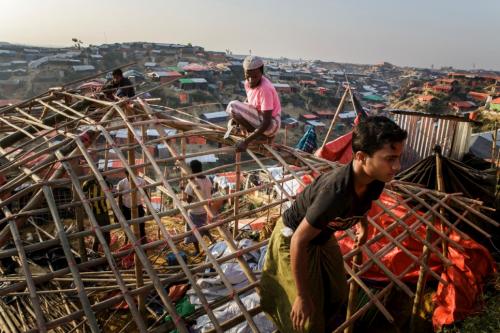UN launches 2018 appeal for Rohingya refugees and Bangladeshi host communities
United Nations agencies and NGO partners on March 16 released, the 2018 Joint Response Plan (JRP) for the Rohingya Humanitarian Crisis, a US$951 million appeal to meet the urgent needs of nearly 900,000 Rohingya refugees and more than 330,000 vulnerable Bangladeshis in the communities hosting them.

Rohingya refugees build a shelter at a settlement in Bangladesh.
Over the months since the outset of the Rohingya influx, this has been the world’s fastest growing refugee crisis, with tens of thousands fleeing by land and sea from Myanmar daily at the peak of the emergency. Some 671,000 Rohingya refugees have arrived in Bangladesh since 25th August 2017. The Bangladesh Government and Bangladeshi people have responded with extraordinary generosity and hospitality.
Almost seven months on, refugees from Myanmar continue to arrive. And the situation in Cox’s Bazar remains fluid. The Kutupalong-Balukhali site, where some 600,000 refugees are now living, is today the largest and most densely populated refugee settlement in the world. Precarious conditions for the refugees and the ongoing emergency response are about to be further challenged by the approaching monsoon season and rains. More than 150,000 Rohingya refugees are in places at risk of landslides and floods, in what could become a disaster on top of the current emergency.
The 2018 appeal for the Rohingya Humanitarian Crisis – launched in Geneva by UN High Commissioner for Refugees Filippo Grandi on March 16, IOM Director General William Swing and UN Resident Coordinator in Bangladesh Mia Seppo - aims to address these challenges, bringing together the critical efforts of more than 100 UN agencies and national and international NGOs. The international humanitarian response aims to ensure refugees and host communities receive the life-saving assistance, protection and support they desperately need, complementing the continuing efforts of the Bangladeshi authorities.
“We are talking about truly critical needs here both on the part of the Bangladeshi communities who have so generously opened their doors, and of a stateless and refugee population that even prior to this crisis was among the world’s most marginalised and at risk,” said High Commissioner for Refugees Filippo Grandi. “The solutions to this crisis lie inside Myanmar, and conditions must be established that will allow refugees to return home. But today we are appealing for help with the immediate needs, and these needs are vast.”
The appeal aims to meet the immediate humanitarian needs of refugees and host communities, and support environmentally sustainable solutions, confidence-building and resilience of affected populations until the end of 2018. It also includes contingency planning for 80,000 more Rohingya refugees in the coming months.
“The needs and vulnerabilities of the Rohingya refugee population in Bangladesh are immense,” said William Swing, IOM Director General. “Many Governments generously supported the last Rohingya crisis appeal. Given the large scale of the emergency and the amount of humanitarian services needed to ensure lives can be protected with dignity, continued and enhanced support is necessary.”
The needs are urgent. The funding will help in meeting the life-saving and acute humanitarian needs both of refugees and of affected host communities. More than half the appeal (54 per cent) is to ensure food, water and sanitation, shelter and other basic aid. Food needs alone account for 25 per cent of the total.
Over 16 million litres of safe water are needed every day for the Rohingya refugee population. Some 12,200 metric tons of food are required every month. At least 180,000 refugee families need cooking fuel. Some 50,000 latrines need to be constructed and maintained, and at least 30 sewage management facilities are required.
Forty-three primary health centres and 144 health posts are needed. Another 5,000 classrooms for 614,000 children and youth must be made available for there to be proper access to education. Some 100 nutrition treatment centres and a range of protection programmes for the 144,000 single mothers and their families and the 22,000 children at risk are also an urgent priority. Around 400,000 children in refugee and host communities require trauma care and related support.
“Obviously there is great appreciation for the generosity with which the response has been funded. But let’s not forget one thing: the biggest donor to this crisis is Bangladesh,” said Mia Seppo, UN Resident Coordinator in Bangladesh.
“In terms of being the first responders, in terms of providing land, in terms of keeping its borders open, in terms of providing asylum, in terms of building roads, extending electricity networks, providing food, seconding civil servants, providing police and army to keep order in the camp. The biggest donor to this crisis continues to be the people and the government of Bangladesh.”
The humanitarian response in Bangladesh faces immense challenges. Conditions are congested, and hundreds of incidents of gender-based violence are reported weekly. Public health concerns are acute, including measles, diphtheria and diarrhoea.
The Rohingya refugee situation in Cox’s Bazar is an acute humanitarian crisis that needs urgent funding to save lives and provide essential aid. So far, the emergency response from September 2017 to February 2018 has received 74 per cent of the funding needed (US$321 million of the US$434 million required).
Source: United Nations High Commissioner for Refugees
- 220 reads
Human Rights
Ringing FOWPAL’s Peace Bell for the World:Nobel Peace Prize Laureates’ Visions and Actions

Protecting the World’s Cultural Diversity for a Sustainable Future

The Peace Bell Resonates at the 27th Eurasian Economic Summit

Declaration of World Day of the Power of Hope Endorsed by People in 158 Nations

Puppet Show I International Friendship Day 2020

